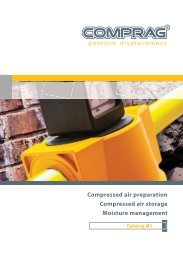AM-AFF_cat_en
You also want an ePaper? Increase the reach of your titles
YUMPU automatically turns print PDFs into web optimized ePapers that Google loves.
Series <strong>AM</strong>/<strong>AFF</strong><br />
Specific Product Precautions 3<br />
Be sure to read this before handling. Refer to back pages 1 and 2 for Safety Instructions,<br />
and “Precautions for Handling Pneumatic Devices” (M-03-E3A) for Common Precautions.<br />
Air Supply<br />
Caution<br />
1. The mist separator is not applicable to gases other<br />
than compressed air.<br />
The mist separator is not applicable to gases other than compressed<br />
air (example: oxyg<strong>en</strong>, hydrog<strong>en</strong>, flammable gas, mixed<br />
gas).<br />
2. Do not use compressed air that contains chemicals,<br />
organic solv<strong>en</strong>ts, salt, or corrosive gases.<br />
Do not use compressed gas containing chemicals, organic<br />
solv<strong>en</strong>ts, salt or corrosive gas. This can cause rust, damage<br />
to rubber and resin parts, or malfunction.<br />
3. Operate within the specified operating pressure<br />
range.<br />
Damage, failure, or malfunction may occur if the mist separator<br />
is operated above the maximum operating pressure.<br />
If the mist separator is used below the minimum operating<br />
pressure, increase in the air-flow resistance due to clogging<br />
will have such influ<strong>en</strong>ce that the desired flow rate cannot be<br />
obtained.<br />
If the mist separator is used under a low pressure such as for<br />
a blower, conduct suffici<strong>en</strong>t tests by users to confirm the specifi<strong>cat</strong>ions<br />
and performances.<br />
Operating Environm<strong>en</strong>t<br />
Caution<br />
1. Do not use in the following <strong>en</strong>vironm<strong>en</strong>ts, as this<br />
can cause failure.<br />
1) In lo<strong>cat</strong>ions having corrosive gases, organic solv<strong>en</strong>ts, and<br />
chemical solutions, or in lo<strong>cat</strong>ions where these elem<strong>en</strong>ts<br />
are likely to adhere to the equipm<strong>en</strong>t.<br />
2) In lo<strong>cat</strong>ions where salt water, water, or water vapor could<br />
come in contact with the equipm<strong>en</strong>t.<br />
3) In lo<strong>cat</strong>ions that is exposed to shocks and vibrations.<br />
2. Be careful about the contamination of the workpieces<br />
due to <strong>en</strong>trainm<strong>en</strong>t of the ambi<strong>en</strong>t air.<br />
If compressed air is used for air blow, compressed air blowing<br />
out from the blow nozzle may <strong>en</strong>train foreign matter (solid particles<br />
and liquid particles) floating in the ambi<strong>en</strong>t air, blowing it<br />
against the workpieces and causing adhesion. Therefore, suffici<strong>en</strong>t<br />
precautions must be tak<strong>en</strong> about the ambi<strong>en</strong>t <strong>en</strong>vironm<strong>en</strong>t.<br />
Maint<strong>en</strong>ance<br />
Caution<br />
1. Replace the elem<strong>en</strong>t immediately wh<strong>en</strong> the time for<br />
its replacem<strong>en</strong>t has arrived.<br />
To replace the elem<strong>en</strong>t, replace the O-ring and the gasket,<br />
too. For the replacem<strong>en</strong>t procedure, refer to the operating manual.<br />
(For elem<strong>en</strong>t dim<strong>en</strong>sions, refer to back page 6.)<br />
<br />
a) <strong>AFF</strong>2C to 22C, 37B, 75B, <strong>AM</strong>150C ~ 550C, 650, 850<br />
The replacem<strong>en</strong>t interval for the elem<strong>en</strong>t is wh<strong>en</strong> the pressure<br />
drop reaches 0.1 MPa or after two years of operation, whichever<br />
comes first. A pressure drop can be verified with the elem<strong>en</strong>t<br />
service indi<strong>cat</strong>or (-T) or with differ<strong>en</strong>tial pressure gauge<br />
(Made to Order).<br />
b) <strong>AM</strong>E<br />
If the elem<strong>en</strong>t has red spots, perform replacem<strong>en</strong>t ev<strong>en</strong> before<br />
the situation has not come to (a).<br />
c) <strong>AM</strong>F<br />
If the secondary side smells of oil, perform replacem<strong>en</strong>t ev<strong>en</strong><br />
before the situation has not come to (a).<br />
2. Be sure to exhaust the drain accumulated in the filter<br />
container.<br />
Failure to discharge the drain will allow the accumulated drain<br />
to flow over to the outlet side.<br />
Wh<strong>en</strong> using the <strong>AFF</strong>2C to 22C, 37B, 75B, <strong>AM</strong>150C to<br />
550C, 650, 850 with drain cock, drain guide or ball valve, discharge<br />
the drain before the drainage level reaches the c<strong>en</strong>tre<br />
of the sight glass. If the drain is not discharged properly, it will<br />
flow over to the outlet side.<br />
Sight glass<br />
Drainage level<br />
Discharge the drain before<br />
reaching the c<strong>en</strong>tre level.<br />
Back page 5

















